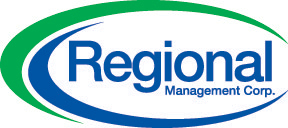Regional Management: Too Much.. Too Soon..

Regional Management sacrificed business and operating model continuity for asset growth.
Business Model
Regional Management, “Regional” or the “Company”, is a publicly traded branch based consumer lender. Regional provides credit to approximately 350,000 near-prime and sub-prime individuals through its 300+ locations based primarily in the Southeast. Regional differentiates itself based on its proprietary direct lending data and its relationships with customers in need of cash liquidity.[1]
Regional offers the following loan products:[1]
- Small Loans: full-amortizing installment loans originated and sourced directly through the branch network, with an average loan size of $1,100 and an average term of 14 months (59% of assets)
- Large Loans: fully-amortizing installment loans originated and sourced directly through the branch network, with an average loan size of $3,700 and an average term of 29 months (8% of assets)
- Automobile Loans: purchase money automobile loans primarily sourced indirectly through dealership networks, with an average loan size of $8,900 and an average term of 53 months (28% of assets)
- Retail Loans: loans for consumer goods primarily sourced indirectly through its retailer network, with an average loan size of $1,000 and an average term of 21 months (5% of assets)

Operating Model
Direct Lending (Small / Large Loans):
Regional operates over 300 branches in geographic locations concentrated with individuals in the Company’s target credit spectrum. Each branch generally has between 3-4 employees and operates as a small-scale lending institution for individuals, often those turned down by the traditional banking sector, seeking a credit advance generally brought on by a specific life event.[1] This type of lending is referred to as direct lending, because the individual comes into the branch to request a loan, and the transaction is consummated at that time.
Lending institutions generate a profit by advancing money at a rate that is high enough to offset three categories of expenses: 1) bad-debt 2) interest 3) SG&A. Two of these expense buckets, bad-debt and SG&A, are key differentiating factors to Regional’s operating model.
Regional manages its bad-debt, the amount of loans that do not repay, based on decades of proprietary direct lending data that has been developed into a scorecard to analyze each customers’ ability and likelihood to repay. Additionally, the size of the loan and the personal nature of the transaction creates a relationship between the branch employee and the customer that becomes crucial to increasing the customer’s propensity to repay.
Regional has an intense focus on managing expenses at the branch level, allowing its branch employees to play a role in all operational aspects of the business resulting in reduced overall headcount. Most of Regional’s locations are small in size and based in rural areas, which places much of the sales and marketing responsibility on each branch manager and pushes him or her to leverage relationships within the local communities to drive origination volume.
Indirect Lending (Auto / Retail Loans):
When a consumer is finalizing the purchase of an automobile or consumer good, he or she is generally presented with the option to finance the purchase. At this point in the transaction, the sales associate will take a certain amount of information from the customer, and that data will be transmitted into large application aggregation service. From there the application will be distributed to all lending institutions that subscribe to the service, each competing to offer the lowest rate, as fast as possible, based on the firms propriety underwriting and processing models.
As Regional considered additional growth avenues, the Company decided to enter the indirect lending industry in 2011, and within 3 years the platform has become 33% of the Company’s total assets.[2] Regional developed its underwriting platform without the same proprietary historical data that made the direct platform so successful, and as a result has had to compete on rate without a clear predictor of loan performance. Additionally, competitors have more advanced IT systems to process applications much faster, resulting in a picked-over pool of applications for Regional to evaluate.
Conclusion
Regional’s core business model and core competency is direct lending through its branch network. As a result of the Company’s primary objective to grow assets, regardless of the source or an understanding of future credit performance, the operating model has diverged from the underlying business model. Regional built its business model and differentiated itself by creating a niche in the lending market and leveraging its deep understanding of direct lending credit history. When the Company adjusted its operating model to focus on indirect lending and drive asset growth, it suffered over time as many of the indirect loans turned unprofitable and caused Regional to completely reassess the way it provisions for loan losses. Lastly, as a result of a lack of focus on direct lending, same-store traditional asset growth has deteriorated. This poor performance has caused the stock price and net income to drop 58% and 49%, respectively, since its peak in 2013.[3][4]
Sources
[1] Regional Management Corp., FY14 Form 10K for the Period Ending December 31, 2014 (filed March 16, 2015), http://www.sec.gov/Archives/edgar/data/1519401/000119312515094003/0001193125-15-094003-index.htm, accessed December 7,2015.
[2] Regional Management Corp., Form S-1 Registration Statement (filed March 15, 2012), http://www.sec.gov/Archives/edgar/data/1519401/000095012312004817/0000950123-12-004817-index.htm, accessed December 7,2015.
[3] Regional Management Corp., Q315 Form 10Q for the Period Ending September 30, 2015 (filed November 14, 2015), http://www.sec.gov/Archives/edgar/data/1519401/000119312512470629/d399057d10q.htm, accessed December 7,2015.
[4] Yahoo Finance, RM Interactive Stock Chart, http://finance.yahoo.com/echarts?s=RM+Interactive#{“range”:”max”,”allowChartStacking”:true}, accessed December 7, 2015.



